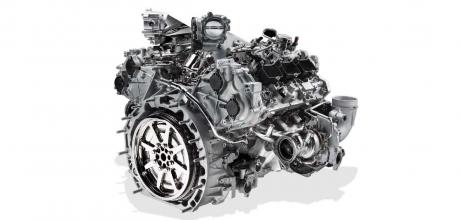Tech Explains: the complicated lineage of the new Alfa supercar’s V6 engine
Success, particularly in Alfa’s corner of Italy, has many fathers. By Ben Miller.
ALFA’S ‘NEW’ V6 ENGINE TECHEXPLAINS
When Alfa blasted back from irrelevance with the M3-baiting Giulia Quadrifoglio, it was hard to know what was more exciting: the way it looked, the way it drove or the amazing racket it made as you gunned it up the road. The engine was, ahem, all-new. ‘The V6 is a ground-up build,’ project leader Philippe Krief told CAR at the time. ‘It is twin-turbo, with a 90° vee angle.
‘What was important for us was the feeling, not necessarily the amount of torque. When you accelerate, you can have all the torque suddenly then nothing, or you can have torque which is increasing, increasing, increasing: we tuned it to have this feeling.’
At this point, the tech-savvy thought of Ferrari, and not just because Krief had worked on the sublime 458 at Ferrari. When it introduced the 488 GTB in 2015, the first in its long line of mid-engined V8s to use turbochargers, it too deliberately restricted torque at lower engine revs to retain a naturally-aspirated feel. And of course back then, before Ferrari’s flotation and Maranello’s detachment from the mothership, the marques were Fiat Chrysler bedfellows. On closer inspection the Alfa V6 had more than a passing resemblance to Ferrari’s F154 V8, with a similar construction, bore and stroke dimensions (86.5 by 82mm for the Alfa, 86.5 by 83mm in the 488) and vee angle. Was this so surprising given the Giulia’s compressed gestation and the number of former Ferrari brains on the team?
And now Alfa has a ‘new’ V6 based heavily on that engine. Set for duty in the new 33 Stradale (unless you opt for the battery-electric powertrain, of course), this version gains pre-chamber ignition, as seen in that other closely- related engine, Maserati’s Nettuno.
Maserati engineers began exploring the technology in 2015 and liked what they saw, with big gains in combustion efficiency. As the name would suggest, the mixture is ignited first in a small chamber linked to the main chamber by profiled ports. The resulting crests of flame ensure a faster and more complete burn. The knock-on advantages are myriad, allowing for a high compression ratio without knocking, a higher specific output and, linked to that increase in power, smaller, less laggy turbochargers.
New 33 Stradale a treat for all the senses.
THE V6 EVOLVED
SUPERCARAPPROPRIATE POWER
Alfa’s claiming more than 620bhp from this slightly bigger, 3.0-litre version of the Quadrifoglio V6. That’s a decent hike over even the most powerful versions of the Giulia, and puts it on par with the 621bhp MC20 Maserati.
F1 THINKING
Pre-chamber ignition was used on the dominant turbo V6 AMG F1 engines of the first hybrid era. By increasing combustion efficiency, the tech boosts power significantly.
WHAT, NOT 120 DEGREES?
120° V6s are popular on cars like the 296 and Artura for their packaging neatness. But this engine has links back to Ferrari’s 90° F154 motor, so the turbos sit either side of the engine rather than hot-in-vee.


